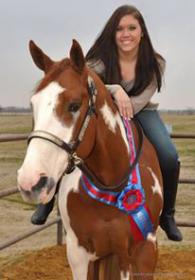A brief search of YouTube shows many videos on training showmanship.
For us, the key was: Make the right response easy and the wrong one hard.
I am sure you know that in-hand work, especially showmanship, is a long training process. My granddaughter loved showmanship, and made it her mission to train her horse so that he could compete at the highest levels against some World and Congress horses. She was successful. Watching her with Max, her horse, was like watching a pair of beautiful dancers. She could move her shoulder slightly and Max would move his hind leg —if she took a step–he took a step. They were amazing --(she grew up and Max still lives with me), When she was 10 she got Max as a birthday present. They spent the next 9 years learning and practicing showmanship. She could and did ride, but showmanship was her thing.
For hours --four hours a day --two hours in the AM and two in the PM, she worked with Max. It took about two years before they started hitting the ribbons --and eventually, they were first or second in every showmanship class they entered.
Now, to your questions —do you have a heavy weight chain and shank and a properly fitted halter? Do you know how to put the chain on the halter (through the side ring, under the chin, out the far side ring and up to the cheek ring is how we did it). We also used a dressage length crop.
Next, always do your showmanship after you ride --but ALWAYS do showmanship after you ride. Take the saddle off, and put the halter on.
Start with training the horse to walk when you walk, and stop when you stop. He is to keep his eye at your shoulder. Walk briskly. If he lags, tug the chain (that’s uncomfortable for the horse) if he surges ahead, pull back. The SECOND the horse walks with you, stop (don’t face the horse, just stop) --do that about 1000 times and the horse will always walk with you on a loose shank. Then move to squaring up. When you stop, face the horse, his eye should be level with the middle of your chest. At that moment, he should put all four of his feet in line (Arabs may have a different stance, I think they do). Have a helper tap-tap-tap front feet until they are aligned. Count to five, and walk on. Do it again (and again and again, 1000 times ) until every time you face horse, those front feet square up. Fortunately, most of the time the back feet teach themselves, but same thing if not.
For backing, be clear in your signal. We say shush, shush, shush. When you step forward your shoulder should almost bump the nose --or it would if horse was not backing up too. Use your dressage crop to tap front legs smartly enough that horse steps back to avoid. Then stop. Go forward. Walk a bit, stop, square, then cue the back–do that 1000 times and the second you say shush or step forward into the horse, he will back. Then work on asking him to do so with his head lower . . .
Ahhh, the pivot --stop worrying about the back legs --they will sort themselves. The pivot is a FORWARD movement. Standing with your bellybutton directly across from the horse’s left eye, hold your dressage whip horizontal and tap-tap-tap the neck --you want horse to step away from you in a sideways, but forward motion. Try for one step, left crossing in front of right --then stop, pause and walk on —do it 10,000 times and you’ll have an amazing pivot. If horse tries to walk off, pull on the nose chain (gently). If you are standing where you should be, and have worked on the standing square exercise first, you won’t have the hind quarters coming at you.
Again, lots of YouTube videos —main thing to remember is Showmanship takes as much time as any upper level discipline —to be great at it, you really have to love it and work very, very hard.




